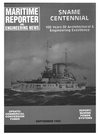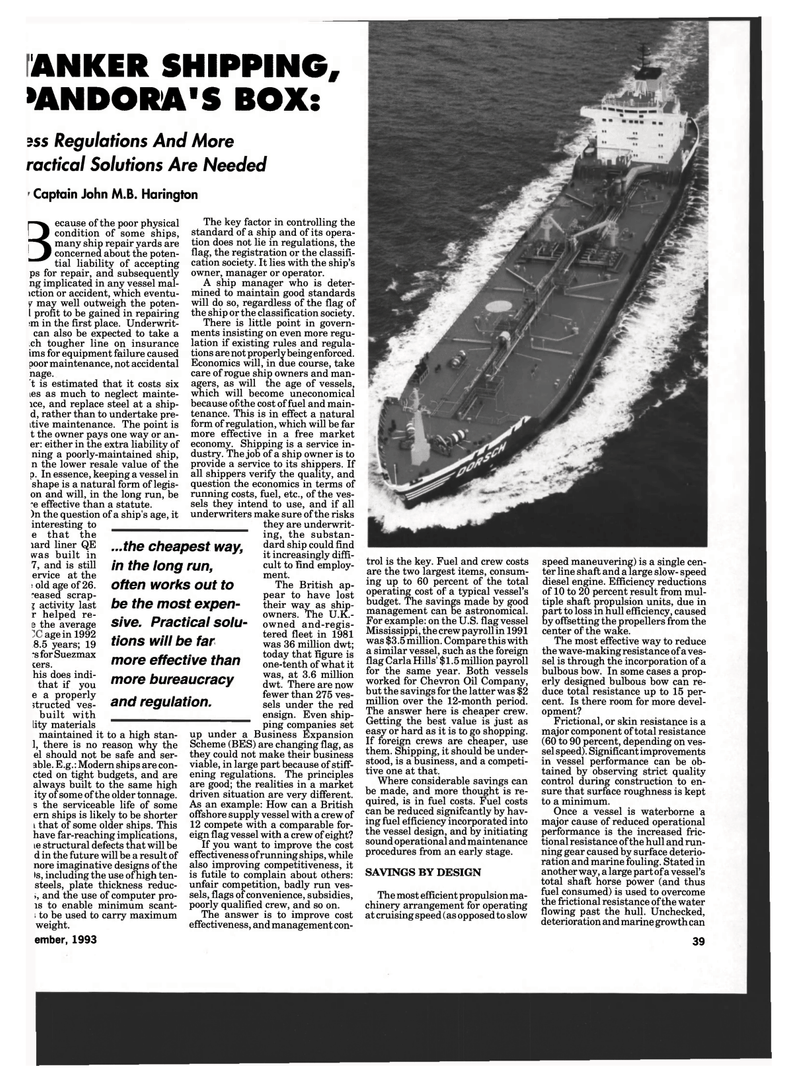
Page 37: of Maritime Reporter Magazine (September 1993)
Read this page in Pdf, Flash or Html5 edition of September 1993 Maritime Reporter Magazine
ANKER SHIPPING, >ANDORA'S BOX: sss Regulations And More ractical Solutions Are Needed
Captain John M.B. Harington
Because of the poor physical condition of some ships, many ship repair yards are concerned about the poten-tial liability of accepting ps for repair, and subsequently ng implicated in any vessel mal- lction or accident, which eventu-
Y may well outweigh the poten- l profit to be gained in repairing im in the first place. Underwrit- can also be expected to take a ich tougher line on insurance ims for equipment failure caused poor maintenance, not accidental nage. 't is estimated that it costs six
Les as much to neglect mainte- lce, and replace steel at a ship- d, rather than to undertake pre- itive maintenance. The point is t the owner pays one way or an- er: either in the extra liability of ning a poorly-maintained ship, n the lower resale value of the p. In essence, keeping a vessel in shape is a natural form of legis- on and will, in the long run, be "e effective than a statute. )n the question of a ship's age, it interesting to e that the lard liner QE was built in 7, and is still ervice at the i old age of 26. "eased scrap- l activity last r helped re- e the average age in 1992 8.5 years; 19 "sforSuezmax ters. his does indi- that if you e a properly structed ves- built with
Lity materials maintained it to a high stan- l, there is no reason why the el should not be safe and ser- able. E.g.: Modern ships are con- cted on tight budgets, and are always built to the same high ity of some of the older tonnage, s the serviceable life of some ern ships is likely to be shorter t that of some older ships. This have far-reaching implications, le structural defects that will be d in the future will be a result of nore imaginative designs of the
Is, including the use of high ten- steels, plate thickness reduc- >, and the use of computer pro- is to enable minimum scant- i to be used to carry maximum weight.
September, 1993 ...the cheapest way, in the long run, often works out to be the most expen- sive. Practical solu- tions will be far more effective than more bureaucracy and regulation.
The key factor in controlling the standard of a ship and of its opera- tion does not lie in regulations, the flag, the registration or the classifi- cation society. It lies with the ship's owner, manager or operator.
A ship manager who is deter- mined to maintain good standards will do so, regardless of the flag of the ship or the classification society.
There is little point in govern- ments insisting on even more regu- lation if existing rules and regula- tions are not properly being enforced.
Economics will, in due course, take care of rogue ship owners and man- agers, as will the age of vessels, which will become uneconomical because of the cost of fuel and main- tenance. This is in effect a natural form of regulation, which will be far more effective in a free market economy. Shipping is a service in- dustry. The job of a ship owner is to provide a service to its shippers. If all shippers verify the quality, and question the economics in terms of running costs, fuel, etc., of the ves- sels they intend to use, and if all underwriters make sure of the risks they are underwrit- ing, the substan- dard ship could find it increasingly diffi- cult to find employ- ment.
The British ap- pear to have lost their way as ship- owners. The U.K.- owned and-regis- tered fleet in 1981 was 36 million dwt; today that figure is one-tenth of what it was, at 3.6 million dwt. There are now fewer than 275 ves- sels under the red ensign. Even ship- ping companies set up under a Business Expansion
Scheme (BES) are changing flag, as they could not make their business viable, in large part because of stiff- ening regulations. The principles are good; the realities in a market driven situation are very different.
As an example: How can a British offshore supply vessel with a crew of 12 compete with a comparable for- eign flag vessel with a crew of eight?
If you want to improve the cost effectiveness of running ships, while also improving competitiveness, it is futile to complain about others: unfair competition, badly run ves- sels, flags of convenience, subsidies, poorly qualified crew, and so on.
The answer is to improve cost effectiveness, and management con- trol is the key. Fuel and crew costs are the two largest items, consum- ing up to 60 percent of the total operating cost of a typical vessel's budget. The savings made by good management can be astronomical.
For example: on the U.S. flag vessel
Mississippi, the crew payroll in 1991 was $3.5 million. Compare this with a similar vessel, such as the foreign flag Carla Hills' $1.5 million payroll for the same year. Both vessels worked for Chevron Oil Company, but the savings for the latter was $2 million over the 12-month period.
The answer here is cheaper crew.
Getting the best value is just as easy or hard as it is to go shopping.
If foreign crews are cheaper, use them. Shipping, it should be under- stood, is a business, and a competi- tive one at that.
Where considerable savings can be made, and more thought is re- quired, is in fuel costs. Fuel costs can be reduced signifcantly by hav- ing fuel efficiency incorporated into the vessel design, and by initiating sound operational and maintenance procedures from an early stage.
SAVINGS BY DESIGN
The most efficient propulsion ma- chinery arrangement for operating at cruising speed (as opposed to slow speed maneuvering) is a single cen- ter line shaft and a large slow- speed diesel engine. Efficiency reductions of 10 to 20 percent result from mul- tiple shaft propulsion units, due in part to loss in hull efficiency, caused by offsetting the propellers from the center of the wake.
The most effective way to reduce the wave-making resistance of a ves- sel is through the incorporation of a bulbous bow. In some cases a prop- erly designed bulbous bow can re- duce total resistance up to 15 per- cent. Is there room for more devel- opment?
Frictional, or skin resistance is a major component of total resistance (60 to 90 percent, depending on ves- sel speed). Significant improvements in vessel performance can be ob- tained by observing strict quality control during construction to en- sure that surface roughness is kept to a minimum.
Once a vessel is waterborne a major cause of reduced operational performance is the increased fric- tional resistance of the hull and run- ning gear caused by surface deterio- ration and marine fouling. Stated in another way, a large part of a vessel's total shaft horse power (and thus fuel consumed) is used to overcome the frictional resistance of the water flowing past the hull. Unchecked, deterioration and marine growth can 39

 36
36

 38
38
